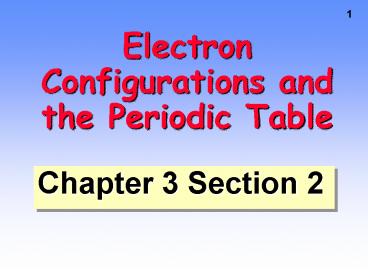Electron Configurations and the Periodic Table PowerPoint PPT Presentation
1 / 24
Title: Electron Configurations and the Periodic Table
1
Electron Configurations and the Periodic Table
- Chapter 3 Section 2
2
Electron Configurations
- Electron configuration the arrangement of
electrons in an atom - The most important of these electrons are the
valence electrons or outermost electrons.
3
Valence Electrons
- The number of valence electrons for all
representative elements is determined by the
number of the group in which the atom is found. - Examples
- Hydrogen - Group IA or 1
- 1 valence electron.
- Fluorine Group VIIA or 17
- 7 valence electrons
4
NOW YOU TRY!
- How many valence electrons do the following
elements contain? - A. Lithium
- B. Carbon
- C. Aluminum
- D. Sulfur
- E. Krypton
1
4
3
6
8
5
So, who cares?
- Valence electrons are important because they
determine how atoms interact with each other to
form compounds!
6
Arrangement of Electrons in Atoms according to
the Quantum Mechanical Model
- Electrons in atoms are arranged as
- ENERGY LEVELS
- SUBLEVELS
- ORBITALS
7
Energy Levels
- Think of the energy level as the relative
distance from the nucleus. Currently, all
electrons for known elements will occupy the
first seven levels, but there is a possibility of
infinite levels.
1
2
3
8
Sublevels AKA Subshells
- The sublevels are named s, p, d, and f and are
listed in increasing energy. - We specify both the energy level and sublevel
when describing an electron, i.e. 1s, 2s, 2p.
9
Determining the number of sublevels
- The first energy level has 1 sublevel 1s.
- The second energy level has 2 sublevels 2s and
2p. - How many sublevels exist on the 3rd energy level?
- What would they be called?
3
3s, 3p, 3d
10
Orbitals
Orbital a specific region of a sublevel
containing a maximum of 2 electrons.
- The p sublevel has 3 orbitals.
- They are called px, py, and pz.
The s sublevel has 1 orbital.
The d sublevel has 5 orbitals.
The f sublevel has 7 orbitals.
11
Shapes of Orbitals
Typical s orbital (sphere)
(peanut)
(double peanut)
Typical f orbital (flower)
12
How many electrons can be in a sublevel?
Remember A maximum of two electrons can be
placed in an orbital.
s sublevel
d sublevel
p sublevel
f sublevel
Number of orbitals
1
3
5
7
Number of electrons
6
10
14
2
13
Aufbau Principle
- An electron occupies the lowest-energy orbital
that can receive it. - This guides how electron configurations are
written.
14
Rules to Remember when Writing Electron
Configurations
- Obtain the number of total electrons from the
periodic table. - Electrons occupy the lowest energy orbitals
first. - Each energy level (n) only contains n sublevels.
- The s sublevel holds 2 e-, the p 6 e-, the d 10
e-, and the f 14 e-. - Follow the filling pattern only moving once each
sublevel is full.
15
Filling Pattern
16
Periodic Table Method Steps
- Find the element for which you are writing the
configuration. - Starting with Hydrogen, write down the energy
level and sublevel. - Count the boxes in the sublevel and add it as a
superscript. - Continue moving through the sublevels until you
reach your destination.
17
Electron Configurations
- 3d7
Number of electrons in the sublevel
Energy Level
Sublevel
1s2 2s2 2p6 3s2 3p6 4s2 3d10 4p6 5s2 4d10 5p6 6s2
4f14 etc.
18
Lets Try It!
- Write the electron configuration for the
following elements - H
- C
- N
- Br
- S
19
Lets Try It!
- Write the electron configuration for the
following elements - H 1s1
- C 1s2 2s22p2
- N 1s2 2s22p3
- Br 1s2 2s2 2p6 3s2 3p6 4s2 3d10 4p5
- S 1s2 2s2 2p6 3s2 3p4
20
Noble Gas Notation
- A way of abbreviating long electron
configurations - Since we are only concerned about the outermost
electrons, we can skip to places we know are
completely full (noble gases), and then finish
the configuration
21
Noble Gas Notation
- Step 1 Find the closest noble gas to the atom,
WITHOUT GOING OVER the number of electrons in the
atom. Write the noble gas in brackets . - Step 2 Find where to resume by finding the next
energy level (row in periodic table). - Step 3 Resume the configuration starting with
ns2 where n is the next level
22
Noble Gas Notation
- Chlorine
- Longhand is 1s2 2s2 2p6 3s2 3p5
- You can abbreviate the first 10 electrons with a
noble gas, Neon. Ne replaces 1s2 2s2 2p6 - The next energy level after Neon is 3
- So you start at level 3 on the diagonal rule (all
levels start with s) and finish the configuration
by adding 7 more electrons to bring the total to
17 - Ne 3s2 3p5
23
Practice Noble Gas Notation
- Write the noble gas notation for each of the
following atoms - Cl
- P
- O
- I
24
Practice Noble Gas Notation
- Write the noble gas notation for each of the
following atoms - Cl Ne3s2 3p5
- P Ne3s2 3p3
- O He2s22p4
- I Kr5s2 4d10 5p5

